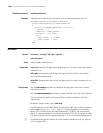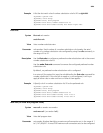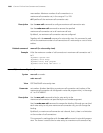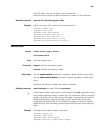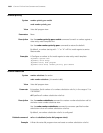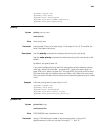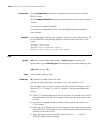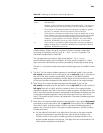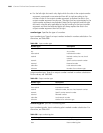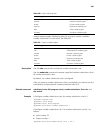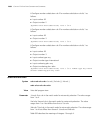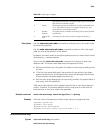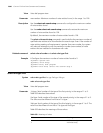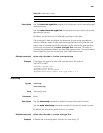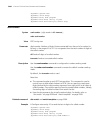
2635
output-number: Output string of a number involved in number substitution,
consisting of characters such as 0 to 9, #, *, and ., up to 31 characters. The
characters are described in Table 687.
The sub-expression (one digit or digit string) before !, %, or + is not
exactly-matched digit(s) and is handled in a similar way the wildcard (.). These
signs cannot be used alone and must be preceded by a valid digit or digit string.
The dot (.) in the input-number and output-number arguments is handled in three
ways:
1 The dot (.) in the output-number argument is considered invalid. If you use the
dot-match command to set the dot match rule to end-only (that is, only dots at
the end of the input number are handled), the dots in the output-number
argument are discarded immediately, and the digits which all the dots at the end
of the input number correspond to are added to the end of the output number.
2 Extra dots in the output-number argument are discarded. If you use the
dot-match command to set the dot match rule to right-left (from right to left) or
left-right (from left to right), and the number of dots in the output-number
argument is greater than that in the input-number argument, all digits which the
dots in the input-number argument correspond to are selected to replace the dots
in the output-number argument one by one from right to left (or from left to
right). The remaining dots (that are not replaced) in the output-number argument
are discarded.
3 Extra dots in the input-number argument are discarded. If you use the dot-match
command to set the dot match rule to right-left (from right to left) or left-right
(from left to right), and the number of dots in the input-number argument is
greater than or equal to that in the output-number argument, the dot handling
includes two cases:
■ For the right-left dot match rule, digits which the dots in the input-number
argument correspond to are extracted from right to left according to the
number of dots in the output-number argument to replace the dots in the
output-number argument one by one. The digits that are not extracted in the
input-number argument are discarded.
Table 687 Meanings of characters in the string argument
Character Meaning
0-9 Digit 0 through 9.
# and * Valid digit each.
. Wildcard, which can match any valid digit. For example, 555.... can match any
number beginning with 555 and ending up with four additional characters.
! The character or sub-expression before the sign does not appear or appears
only once. For example, 56!1234 can match 51234 and 561234.
+ The character or sub-expression before the plus sign can appear one or more
times. However, if the plus sign appears at the head of a number, the number
is an E.164 number and the plus sign itself does not represent a specific
number or number repetition. For example, 9876(54)+ can match 987654,
98765454, 9876545454, and so on, and +110022 is an E.164 number.
% The character or sub-expression before the percent sign does not appear or
appears multiple times. For example, 9876(54)% can match 9876, 987654,
98765454, 9876545454, and so on.




